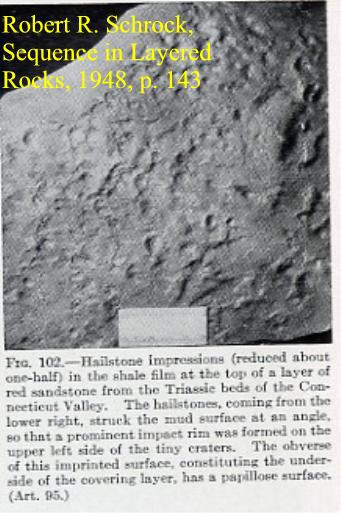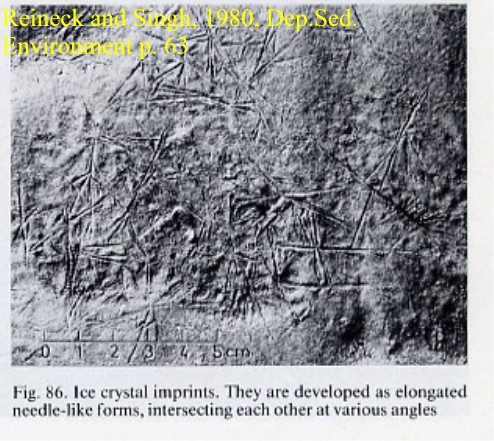Creation Science Articles
Tracks and Raindrop, Hail and Ice Impressions Demonstrates Slow Deposition
Copyright 2004 G.R. Morton. This can be freely distributed so long as no changes are made and no charges are made.
One of the fascinating aspects of the geologic and paleontologic record involves the capturing in stone of slow processes which are incompatible with the young-earth creationist idea of a global flood. Below is a modern slab of hardened mud taken from the Bay of Fundy. It shows that when the mud was soft, a bird walked across it. The bird feet sank into the mud. But then at a later time, after the bird took his stroll, it rained and a few drop imprints were left in the mud, which then hardened. This preservation took place about 60 years ago. The slab of hardened mud was pried up from the sediments around the Bay of Fundy and moved to a museum.
From this, we know that such features can form today, that they don't require exceptionally catastrophic conditions for their formation, and thus when we see such things in the fossil record, we are not free to claim that such features need a global flood. Besides, several things are very clear from this type of deposit.
1. The water depth was no deeper than the bird's legs.
2. When the rain happened, there was no water covering the layer at all. If there had been, the water would have absorbed the drops impact rather than the mud.
From this we know that this modern feature was formed without any water covering at all.
Just for completeness sake, here is another modern example of raindrop imprint preservation.

Now, we find similar things in the fossil record. Below is one from the Triassic of Massachusetts.
One can see two animals walked across this slab, one (NE-SW) while the mud was very wet, the other (E-W) while the mud was a bit dryer. At the last, you can see tiny circular raindrop impressions all over the slab. Like the modern examples above, we don't have to appeal to a global flood to form such slabs. And such slabs show that there was a period of time while various animals walked on the mud, and while the mud slowly dried out allowing a firmer track impression on the east west track.
One of my favorite track photos is from Raymond Moore's 1933 Historical Geology. It shows a shoreline with a dinosaur walking into the water (not fleeing from the water). The slab above the waterline is rainpitted, below the waterline, there are no raindrop impressions because the water absorbed the impact.
This simply doesn't look like a global flood deposit.
But it just isn't raindrops which are found in the fossil record. Hail impressions are preserved as well.

Below we can also see modern vs. ancient ice crystal imprints. Remember that to form ice crystals, the mud must freeze, and this takes several hours, which is inconsistent with a one-year global flood which deposits 50-100 feet per day.
Here are the modern ice crystal imprints.

This example is from the Devonian.

The features discussed above clearly don't require a global flood to form. Indeed, quite the opposite, they indicate a slow rate of deposition.
Did you know that you can be a Christian,
and believe that the earth is billions of years old? The
author of this article, Glenn Morton, made the transition from young
earth creationism to old earth creationism. To learn more
about old earth creationism, see
Old Earth Belief,
or check out the article
Can You Be A
Christian and Believe in an Old Earth?
Feel free to check out more of this website. Our goal is to
provide rebuttals to the bad science behind young earth creationism,
and honor God by properly presenting His creation.
